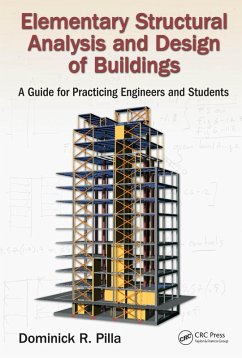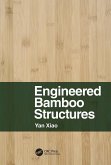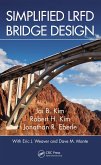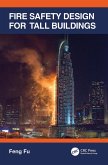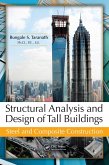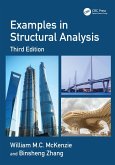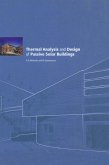Elementary Structural Analysis and Design of Buildings (eBook, ePUB)
A Guide for Practicing Engineers and Students


Alle Infos zum eBook verschenken

Elementary Structural Analysis and Design of Buildings (eBook, ePUB)
A Guide for Practicing Engineers and Students
- Format: ePub
- Merkliste
- Auf die Merkliste
- Bewerten Bewerten
- Teilen
- Produkt teilen
- Produkterinnerung
- Produkterinnerung

Hier können Sie sich einloggen

Bitte loggen Sie sich zunächst in Ihr Kundenkonto ein oder registrieren Sie sich bei bücher.de, um das eBook-Abo tolino select nutzen zu können.
This overview of the analysis and design of buildings runs from basic principles and elementary structural analysis to the selection of structural systems and materials, and on to foundations and retaining structures. It presents a variety of approaches and methodologies while featuring realistic design examples.
As a comprehensive guide and desk reference for practicing structural and civil engineers, and for engineering students, it draws on the author's teaching experience at The City College of New York and his work as a design engineer and architect. It is especially useful for those…mehr
- Geräte: eReader
- mit Kopierschutz
- eBook Hilfe
- Größe: 14.54MB
![Engineered Bamboo Structures (eBook, ePUB) Engineered Bamboo Structures (eBook, ePUB)]() Yan XiaoEngineered Bamboo Structures (eBook, ePUB)46,95 €
Yan XiaoEngineered Bamboo Structures (eBook, ePUB)46,95 €![Simplified LRFD Bridge Design (eBook, ePUB) Simplified LRFD Bridge Design (eBook, ePUB)]() Simplified LRFD Bridge Design (eBook, ePUB)52,95 €
Simplified LRFD Bridge Design (eBook, ePUB)52,95 €![Elementary Behaviour of Composite Steel and Concrete Structural Members (eBook, ePUB) Elementary Behaviour of Composite Steel and Concrete Structural Members (eBook, ePUB)]() Deric J. OehlersElementary Behaviour of Composite Steel and Concrete Structural Members (eBook, ePUB)56,95 €
Deric J. OehlersElementary Behaviour of Composite Steel and Concrete Structural Members (eBook, ePUB)56,95 €![Fire Safety Design for Tall Buildings (eBook, ePUB) Fire Safety Design for Tall Buildings (eBook, ePUB)]() Feng FuFire Safety Design for Tall Buildings (eBook, ePUB)57,95 €
Feng FuFire Safety Design for Tall Buildings (eBook, ePUB)57,95 €![Structural Analysis and Design of Tall Buildings (eBook, ePUB) Structural Analysis and Design of Tall Buildings (eBook, ePUB)]() Bungale S. TaranathStructural Analysis and Design of Tall Buildings (eBook, ePUB)216,95 €
Bungale S. TaranathStructural Analysis and Design of Tall Buildings (eBook, ePUB)216,95 €![Examples in Structural Analysis (eBook, ePUB) Examples in Structural Analysis (eBook, ePUB)]() William M. C. McKenzieExamples in Structural Analysis (eBook, ePUB)67,95 €
William M. C. McKenzieExamples in Structural Analysis (eBook, ePUB)67,95 €![Thermal Analysis and Design of Passive Solar Buildings (eBook, ePUB) Thermal Analysis and Design of Passive Solar Buildings (eBook, ePUB)]() Ak AthienitisThermal Analysis and Design of Passive Solar Buildings (eBook, ePUB)47,95 €
Ak AthienitisThermal Analysis and Design of Passive Solar Buildings (eBook, ePUB)47,95 €-
-
-
As a comprehensive guide and desk reference for practicing structural and civil engineers, and for engineering students, it draws on the author's teaching experience at The City College of New York and his work as a design engineer and architect. It is especially useful for those taking the National Council of Examiners for Engineering and Surveying SE exam.
Dieser Download kann aus rechtlichen Gründen nur mit Rechnungsadresse in A, B, BG, CY, CZ, D, DK, EW, E, FIN, F, GR, HR, H, IRL, I, LT, L, LR, M, NL, PL, P, R, S, SLO, SK ausgeliefert werden.
- Produktdetails
- Verlag: Taylor & Francis eBooks
- Seitenzahl: 272
- Erscheinungstermin: 19. September 2017
- Englisch
- ISBN-13: 9781315314501
- Artikelnr.: 55407780
- Verlag: Taylor & Francis eBooks
- Seitenzahl: 272
- Erscheinungstermin: 19. September 2017
- Englisch
- ISBN-13: 9781315314501
- Artikelnr.: 55407780
- Herstellerkennzeichnung Die Herstellerinformationen sind derzeit nicht verfügbar.
1.1 Loads
1.2 Dead Loads
1.3 Live Loads
1.3.1 Reduction in Uniform Live loads
1.4 Snow Loads
1.4.1 Flat roof Snow Loads
1.4.2 Minimum Snow Load
1.4.3 Snow Drifts on Lower Roof
1.5 Thermal Loading
1.6 Forces and Loads Due to Soil Pressures
1.6.1 Active and Passive Lateral Pressure
1.6.2 Static Lateral Soil Pressure
1.6.3 Hydrostatic Pressure
1.6.4 Bearing Pressure
2. Wind and Seismic Forces Applied to Buildings
2.1 Lateral Loads
2.2 Wind Loads
2.3 Horizontal Seismic Loads
2.4 Vertical Seismic Load Effect
3. Lateral force Distribution
3.1 Wall Rigidities
3.2 Relative Rigidity Force Distribution (Rigid Diaphragm Analysis)
3.2.1 Center of Mass
3.2.2 Center of Rigidity
3.2.3 Polar Moment of Inertia
3.2.4 Eccentricity
3.2.5 Wall Shears (Direct and Torsional)
3.2.6 Design Wall Shears
3.3 Flexible Diaphragms
3.4 Seismic Static Force Procedure
3.4.1 Equivalent Lateral Force Method
3.5 Horizontal and Vertical Irregularities
4. Methods
4.1 Frame Analysis by Approximate Methods
4.1.1 Analysis of Building Frames for Vertical Loads
4.1.2 Analysis of Building Frames for Lateral Loads
5. Design and Detailing of Structures
5.1 Lateral Force Resisting Systems
5.1.1 Bearing Wall Systems
5.1.2 Building Frame Systems
5.1.3 Moment Resisting Frame Systems
5.1.4 Dual Systems with Special Moment Frames
5.1.5 Dual Systems with Intermediate Moment Frames
5.1.6 Cantilever Column System
5.2 Load Combinations
5.3 Building Drift
5.4 Redundancy Factors
5.5 Overstrength
5.6 Structural systems Integration
6. Steel
6.1 Introduction to Lateral Steel Design
6.2 Special Concentrically Braced Frames
6.2.1 Brace Design
6.2.2 Frame Design
6.2.3 Column Design
6.2.4 Beam Design
7. Concrete
7.1 Introduction to Lateral Concrete Design
7.2 Shear Wall Systems
7.3 Moment Frame Systems
8. Wood
8.1 Introduction to Lateral Wood Design
8.2 Plywood Diaphragm Design
8.3 Shear Walls and Collectors
9. Masonry
9.1 Introduction to Lateral Masonry Design
9.2 Building Wall Design for In-Plane Loads
9.3 Building Wall Design for Out-of-Plane Loads
10. Foundations and Retaining Structures
10.1 Types of Foundations
10.2 Spread Footings
10.2.1 Concentrically Loaded Footings
10.2.2 Eccentrically Loaded Footings
10.3 Mat-Slab Foundations
10.3.1 Combined Footing
10.4 Deep Foundations
10.4.1 Pile Caps
10.5 Retaining Structures
10.5.1 Foundation Walls
10.5.2 Free Standing Cantilevered Retaining Walls
11. Structural Review of Construction
11.1 Construction Administration
11.2 Special Inspections and Structural Observations
1.1 Loads
1.2 Dead Loads
1.3 Live Loads
1.3.1 Reduction in Uniform Live loads
1.4 Snow Loads
1.4.1 Flat roof Snow Loads
1.4.2 Minimum Snow Load
1.4.3 Snow Drifts on Lower Roof
1.5 Thermal Loading
1.6 Forces and Loads Due to Soil Pressures
1.6.1 Active and Passive Lateral Pressure
1.6.2 Static Lateral Soil Pressure
1.6.3 Hydrostatic Pressure
1.6.4 Bearing Pressure
2. Wind and Seismic Forces Applied to Buildings
2.1 Lateral Loads
2.2 Wind Loads
2.3 Horizontal Seismic Loads
2.4 Vertical Seismic Load Effect
3. Lateral force Distribution
3.1 Wall Rigidities
3.2 Relative Rigidity Force Distribution (Rigid Diaphragm Analysis)
3.2.1 Center of Mass
3.2.2 Center of Rigidity
3.2.3 Polar Moment of Inertia
3.2.4 Eccentricity
3.2.5 Wall Shears (Direct and Torsional)
3.2.6 Design Wall Shears
3.3 Flexible Diaphragms
3.4 Seismic Static Force Procedure
3.4.1 Equivalent Lateral Force Method
3.5 Horizontal and Vertical Irregularities
4. Methods
4.1 Frame Analysis by Approximate Methods
4.1.1 Analysis of Building Frames for Vertical Loads
4.1.2 Analysis of Building Frames for Lateral Loads
5. Design and Detailing of Structures
5.1 Lateral Force Resisting Systems
5.1.1 Bearing Wall Systems
5.1.2 Building Frame Systems
5.1.3 Moment Resisting Frame Systems
5.1.4 Dual Systems with Special Moment Frames
5.1.5 Dual Systems with Intermediate Moment Frames
5.1.6 Cantilever Column System
5.2 Load Combinations
5.3 Building Drift
5.4 Redundancy Factors
5.5 Overstrength
5.6 Structural systems Integration
6. Steel
6.1 Introduction to Lateral Steel Design
6.2 Special Concentrically Braced Frames
6.2.1 Brace Design
6.2.2 Frame Design
6.2.3 Column Design
6.2.4 Beam Design
7. Concrete
7.1 Introduction to Lateral Concrete Design
7.2 Shear Wall Systems
7.3 Moment Frame Systems
8. Wood
8.1 Introduction to Lateral Wood Design
8.2 Plywood Diaphragm Design
8.3 Shear Walls and Collectors
9. Masonry
9.1 Introduction to Lateral Masonry Design
9.2 Building Wall Design for In-Plane Loads
9.3 Building Wall Design for Out-of-Plane Loads
10. Foundations and Retaining Structures
10.1 Types of Foundations
10.2 Spread Footings
10.2.1 Concentrically Loaded Footings
10.2.2 Eccentrically Loaded Footings
10.3 Mat-Slab Foundations
10.3.1 Combined Footing
10.4 Deep Foundations
10.4.1 Pile Caps
10.5 Retaining Structures
10.5.1 Foundation Walls
10.5.2 Free Standing Cantilevered Retaining Walls
11. Structural Review of Construction
11.1 Construction Administration
11.2 Special Inspections and Structural Observations
